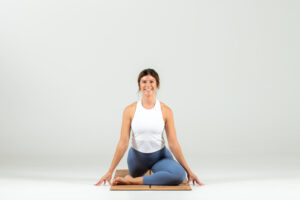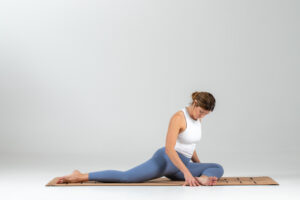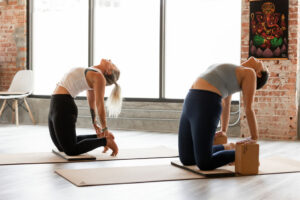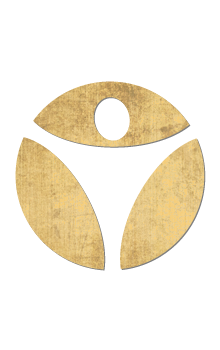Pigeon Pose Modifications | How To Modify Pigeon Pose When You Are An Inflexible Beginner
- Updated on: November 5, 2021
Pigeon pose is a helpful stretch for the hips and glutes. It’s one of our favorite poses and it’s a must for anyone who is looking for back pain relief, anyone who sits in a chair at work, and it’s especially helpful for athletes who want to stay injury free. In this article, we’ll show you how to modify pigeon pose when you have mobility restrictions such as tight hips, tight glutes, and knee injuries. You should consider a modification if you experience the following:
-
Excessive tightness and limited mobility in the hips and thighs
-
Excessive discomfort in the knees
-
Weakened or underdeveloped core
-
Excessive tension or pinching in the back
-
Discomfort or restriction in the shoulders
-
Excessive tightness and limited mobility in the hips and thighs:
The easiest way to create more ease and comfort in Pigeon Pose when you have overly tight or limited mobility in the hips and thighs is to place some kind of support under your hips. A pillow or a block works great for this. Simply place the support under the hip that is unable to fully rest on the ground. This allows you to safely rest your weight into your hips while working at your own level of mobility. To do this, place the block on its low or middle height (depending on your needs) beneath your right glutes if your right leg is forward. You will still want to keep your weight evenly distributed through both hips, so don’t put all of your weight on the block.
Beginners who are particularly tight in the hips should be careful about easing into the pose and about putting too much weight into the hips. To distribute some of the weight, beginners can use the ground to help support body weight by using your hands for leverage on a yoga mat. For even more support, use blocks to raise the height of the ground. This will help lessen some of the weight on the hips.
If you are unable to externally rotate your hips, you can practice King Arthur’s Pose instead. To do this pose, begin on all fours facing the top of your mat. Make sure your knees are hip’s width apart. Bring your right foot forward and plant it just inside your right hand. Stack your right knee over your right ankle, and align your right hip with your right knee. Slide your left knee back just far enough to feel a stretch in the front of the thigh. Engage your core and press your front foot firmly into the ground. Shift your weight forward slightly to lift your back foot off the ground. Make sure you are not resting weight directly on the left kneecap. Instead, engage your core to provide lifting support, and place only a slight weight just above the left knee, if needed. Reach back with your left hand to grab your left foot. You can also use a strap, if needed, by holding one end of the strap in your left hand and looping the other end around the right foot or ankle. Keep the hips squared forward. Continue to engage the core, press through the right foot and shift the hips slightly forward to initiate the stretch in the front of the left thigh.
-
Excessive discomfort in the knees:
-
Place a folded blanket under your back knee to add some cushion and support for the back knee.
-
Alternatively, you can curl the back toes under, lifting the back heel off the ground (pointing it away from your hip). Then press through the ball of the foot to lift the knee just slightly off the ground. This may intensify the stretch in the front of the thigh for some, so proceed with caution.
-
If you are feeling discomfort in the front bent knee, try elevating your hips off the ground by placing a pillow or block beneath your hips. This decreases the intensity of the bend in the front knee, while still receiving the many benefits of the pose.
-
Weakened or underdeveloped core:
-
If you have difficulty keeping your core engaged during this pose, you can rest on your forearms or, if you have the flexibility, let your chest and belly rest on your front leg with your arms outstretched on the ground overhead. Let your forehead rest on a block or on the floor, respectively.
-
Excessive tension or pinching in the back:
-
The first and simplest modification to make when feeling excessive tension or pinching in the back is to engage your core more actively. It’s easy to get caught up on what leg is going where and what to bend when, therefore forgetting to keep the core engaged. Active core support is what protects the back from being overstretched.
-
Another modification is to take the hands forward a little so that the shoulders are leaning toward the hips. This decreases the arch in the spine, so that you can get a stretch without overdoing it.
-
If you are struggling with an inflexible back in this pose, walk your hands forward letting your torso fold down toward the ground. You can rest on your forearms or, if you have the flexibility, let your chest and belly rest on your front leg with your arms outstretched on the ground overhead. Let your forehead rest on a block or on the floor, respectively.
-
Reclined Figure Four Stretch is another variation that can be practiced if you have excessive back tension. This pose is performed lying on your back on the ground, and provides additional support to the back. To do this pose, begin by lying on your back with your knees bent to the sky and your feet planted on the ground in front of your hips. Your arms can rest at your sides. Place the outside of your left ankle just above the right knee making a figure 4 shape with your legs. Reach through your legs to clasp your hands behind your right thigh, and gently pull your legs toward your chest. Keep your lower back on the ground. Press the left knee forward (away from the body) to increase the stretch. Press the toes of the left foot toward the left to activate the ball of the foot. Repeat on the other side.
Finally, you can practice a variation using a chair called Gentleman’s Stretch. To do this, sit on a chair, place the outside of your left ankle just above the right knee making a figure 4 shape with your legs. Gently press your left knee toward the ground and sit up as tall as you can. Lift your chest forward and up as you hinge forward to intensify the stretch in the outer hip and glutes. This will feel like you are bringing your chest toward the wall in front of you rather than toward your legs. Flex your toes back toward your shin to activate the ball of your foot. Squeeze your inner thigh to keep the pose active. Try to externally rotate your hip so that your inner thigh is facing the sky and the outer thigh is facing the ground. Repeat on the other side.
-
Go Deeper:
-
For those with a strong core and hip flexibility, try raising your arms up overhead during Pigeon Pose. Use your core to support the lifting of the posture.
-
Alternatively, you can use a strap for support when raising your arms. To do so, hold one end of the strap in each hand, taking advantage of the tension in the strap to help lower your shoulder blades toward each other.
For more pigeon pose tips, including a list of common mistakes that beginners make, check out another article that we wrote here.
Recent Posts
Categories
Related Articles


Yoga For Men – How To Do A Pigeon Stretch

Common Mistakes Beginners Make In Pigeon Pose
Related Articles

Yoga for the inflexible
I’m sure you’ve said it or heard it before, “I’m not flexible enough for yoga.” Today we’re going to DEBUNK that thought. Any body can

Yoga Modifications After A Knee Injury
Yoga Modifications After Knee Surgery Starting or returning to a yoga practice after a knee injury can be intimidating. The last thing you want to

Beginner’s Modifications For Thread The Needle Pose
Thread The Needle is a restorative pose that can help stretch your shoulders, neck, and back while increasing mobility in the spine. However, you should
